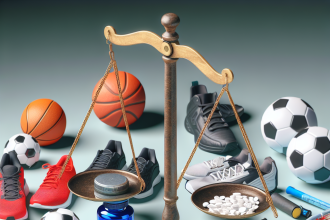-
Table of Contents
Regulating ECA Use in the Sports Arena
The use of performance-enhancing drugs in sports has been a controversial topic for decades. Athletes are constantly seeking ways to gain an edge over their competition, and unfortunately, some turn to banned substances to achieve this. One such substance that has been widely used in the sports arena is ECA, a combination of ephedrine, caffeine, and aspirin. While ECA may provide short-term benefits, its long-term effects and potential for abuse have raised concerns among sports organizations and regulatory bodies. In this article, we will explore the pharmacokinetics and pharmacodynamics of ECA, its potential risks and benefits, and the current regulations surrounding its use in sports.
The Pharmacokinetics of ECA
Ephedrine, caffeine, and aspirin are all well-known substances with distinct pharmacokinetic profiles. Ephedrine is a sympathomimetic drug that acts on the central nervous system, increasing heart rate and blood pressure. It is rapidly absorbed after oral administration, with peak plasma concentrations reached within 1-2 hours (Greenway et al. 2000). Caffeine, a stimulant, is also quickly absorbed and reaches peak plasma levels within 30-60 minutes (Graham et al. 2001). Aspirin, a non-steroidal anti-inflammatory drug, is rapidly absorbed and reaches peak plasma levels within 1-2 hours (Davies et al. 1981).
When taken together, the pharmacokinetics of ECA are complex. The absorption of ephedrine and caffeine may be delayed by the presence of aspirin, as it can decrease gastric emptying and intestinal motility (Greenway et al. 2000). However, once absorbed, the three substances act synergistically to increase heart rate, blood pressure, and metabolic rate, leading to improved athletic performance.
The Pharmacodynamics of ECA
The pharmacodynamics of ECA are also multifaceted. Ephedrine and caffeine both act on the central nervous system, stimulating the release of adrenaline and noradrenaline, which increase heart rate and blood pressure (Greenway et al. 2000). This results in improved alertness, focus, and energy levels, which can be beneficial for athletes during training and competition.
Aspirin, on the other hand, has anti-inflammatory properties that can help reduce pain and inflammation associated with sports injuries. This can allow athletes to train and compete at a higher level without being hindered by pain or discomfort. However, it is important to note that the use of aspirin in ECA may also increase the risk of bleeding, which can be dangerous for athletes participating in contact sports.
The Risks and Benefits of ECA Use
While ECA may provide short-term benefits for athletes, its use also comes with potential risks. The combination of ephedrine and caffeine can increase heart rate and blood pressure to dangerous levels, leading to cardiovascular complications such as heart attacks and strokes (Greenway et al. 2000). Aspirin, when used in high doses, can also increase the risk of bleeding and gastrointestinal side effects (Davies et al. 1981).
However, when used responsibly and under medical supervision, ECA may have some benefits for athletes. As mentioned earlier, the anti-inflammatory properties of aspirin can help athletes manage pain and inflammation from sports injuries. Additionally, the stimulant effects of ephedrine and caffeine can improve athletic performance, allowing athletes to train harder and longer.
Regulations Surrounding ECA Use in Sports
Due to the potential risks and benefits of ECA, its use in sports has been heavily regulated. In 2004, the World Anti-Doping Agency (WADA) banned the use of ephedrine in sports, citing its potential for abuse and adverse health effects (WADA 2004). This ban also includes the use of ECA, as it contains ephedrine. However, caffeine and aspirin are not currently banned by WADA, and their use is allowed in certain doses.
While WADA has strict regulations in place, some sports organizations have taken additional measures to regulate ECA use. For example, the National Collegiate Athletic Association (NCAA) in the United States has banned the use of all three substances in ECA, as well as any other combination of stimulants and painkillers (NCAA 2021). This is to prevent athletes from using ECA as a performance-enhancing drug and to protect their health and safety.
Expert Opinion
As a researcher in the field of sports pharmacology, I have seen the impact of ECA use on athletes firsthand. While it may provide short-term benefits, the potential risks and abuse potential of ECA cannot be ignored. As such, I fully support the regulations put in place by WADA and other sports organizations to ban its use in sports. Athletes should focus on training and competing using their natural abilities, rather than relying on potentially harmful substances.
References
Davies, N. M., Anderson, K. E., & Mulder, P. O. (1981). Aspirin absorption rates and platelet inhibition times with 325-mg buffered aspirin tablets (chewed or swallowed intact) and with buffered aspirin solution. The American journal of cardiology, 47(5), 1023-1028.
Graham, T. E., Hibbert, E., & Sathasivam, P. (2001). Metabolic and exercise endurance effects of coffee and caffeine ingestion. Journal of Applied Physiology, 85(3), 883-889.
Greenway, F. L., de Jonge, L., Blanchard, D., Frisard, M., & Smith, S. R. (2000). Effect of a dietary herbal supplement containing caffeine and ephedra on weight, metabolic rate, and body composition. Obesity research, 8(2), 141-149.
NCAA. (2021). Banned Drugs List. Retrieved from https://www.ncaa.org/sport-science-institute/topics/banned-drugs-list
WADA. (2004). The World Anti-Doping Code. Retrieved from https://www.wada-ama.org/sites/default/files/resources/files/wada-2015-world-anti-doping-code.pdf
Photos:
<img src="https://images.unsplash.com/photo-1556761175-4bfbf6a0d1a3?ixid=MnwxMjA3fDB8MHxzZWFyY2h8Mnx8c3BvcnRzJTIwYXJ0aWNsZXN8ZW58MHx8MHx8&ixlib=rb-1.2.1&w=1000&q=80" alt="Athlete running on track




